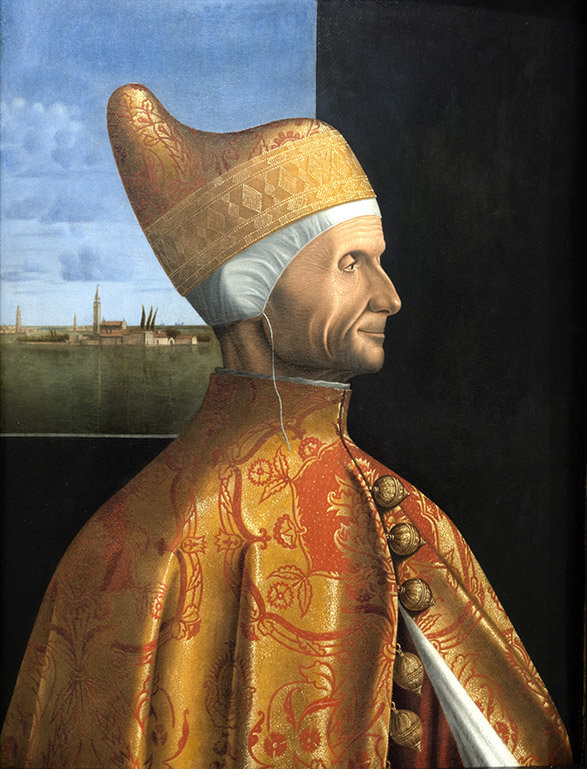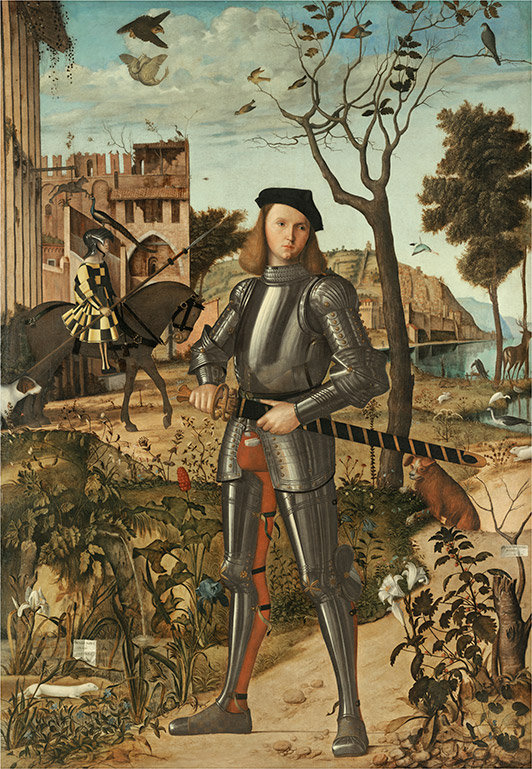Venetian Renaissance Artist Vittore Carpaccio Presented in First Retrospective Outside of Italy
Vittore Carpaccio, Virgin Reading, c. 1510, oil on canvas transferred from panel, overall: 78 x 51 cm (30 11/16 x 20 1/16 in.), framed: 119.7 x 86.4 x 10 cm (47 1/8 x 34 x 3 15/16 in.), National Gallery of Art, Washington, Samuel H. Kress Collection
Washington, DC—A leading figure in the art of Renaissance Venice, Vittore Carpaccio (c. 1460/1466–1525/1526) is best known for his large, spectacular narrative paintings that brought sacred history to life. Celebrated in his native city of Venice for centuries, beloved for his observant eye, fertile imagination, and storytelling prowess, Carpaccio remains little known in the U.S.—except as a namesake culinary dish, "Steak Carpaccio.”
Vittore Carpaccio: Master Storyteller of Renaissance Venice is set to establish the artist’s reputation among American visitors with this, his first retrospective ever held outside Italy. The exhibition will be on view at the National Gallery of Art from November 20, 2022, through February 12, 2023. Some 45 paintings and 30 drawings will include large-scale canvases painted for Venice’s charitable societies and churches alongside smaller works that decorated the homes of prosperous Venetians. The exhibition is organized by the National Gallery and Musei Civici di Venezia, also the organizers of the 2019 exhibition Tintoretto: Artist of Renaissance Venice.
Vittore Carpaccio, Doge Leonardo Loredan, c. 1501/1504, oil on panel, Fondazione Musei Civici de Venezia, Museo Correr, Cl. I no. 43
Vittore Carpaccio: Master Storyteller of Renaissance Venice is set to establish the artist’s reputation among American visitors with this, his first retrospective ever held outside Italy. The exhibition will be on view at the National Gallery of Art from November 20, 2022, through February 12, 2023. Some 45 paintings and 30 drawings will include large-scale canvases painted for Venice’s charitable societies and churches alongside smaller works that decorated the homes of prosperous Venetians. The exhibition is organized by the National Gallery and Musei Civici di Venezia, also the organizers of the 2019 exhibition Tintoretto: Artist of Renaissance Venice.
Several paintings have been newly conserved for the exhibition. Two of Carpaccio’s best-known canvases from the Scuola degli Schiavoni were treated with the support of Save Venice, the organization dedicated to the preservation of the city’s cultural heritage: Saint Augustine in His Study (shortly after 1502) and Saint George and the Dragon (c. 1504–1507). Other treatments uncover discoveries about the original compositions. National Gallery conservator Joanna Dunn’s treatment of the museum’s Virgin Reading (c. 1505) reveals a baby Jesus previously hidden beneath a later repainting that sought to disguise where the painting had been cut down centuries ago.
Vittore Carpaccio, Saint Augustine in His Study, shortly after 1502, oil and tempera on canvas, Scuola Dalmata dei Santi Giorgio e Trifone, Venice. Photo credit: Matteo De Fina.
Vittore Carpaccio, Saint George and the Dragon and Four Scenes from the Martyrdom of Saint George, 1516, oil on canvas, Abbazia di San Giorgio Maggiore, Benedicti Claustra Onlus, Venice. Photo by Matteo De Fina, image © Courtesy of Abbazia di San Giorgio Maggiore - Benedicti Claustra Onlus
The two paintings from the Scuola degli Schiavoni are among several works never before exhibited outside Italy, including the full, six-painting narrative cycle, Life of the Virgin (c. 1502–1508) made for the Scuola di Santa Maria degli Albanesi. The exhibition also includes the reunification of Fishing and Fowling on the Lagoon (c. 1492/1494) from the J. Paul Getty Museum and Two Women on a Balcony (c. 1492/1494) from Venice’s Museo Correr—two paintings that likely adorned a folding door.
Vittore Carpaccio, A Young Knight, 1510, oil on canvas, Museo Thyssen-Bornemisza, Madrid
The exhibition is organized by the National Gallery of Art and Musei Civici di Venezia.
The exhibition is made possible by the leadership support of Constance J. Milstein.
Additional funding is provided by the Director's Circle of the National Gallery of Art and the Annenberg Fund for the International Exchange of Art.
The exhibition is supported by an indemnity from the Federal Council on the Arts and the Humanities.
The exhibition is curated by Peter Humfrey, internationally recognized scholar of 15th- and 16th-century Venetian painting and Professor Emeritus of art history at the University of St Andrews, Scotland, in collaboration with Andrea Bellieni, curator at the Musei Civici di Venezia, and Gretchen Hirschauer, curator of Italian and Spanish painting at the National Gallery of Art.
Vittore Carpaccio, The Flight into Egypt, 1516/1518, oil on panel, National Gallery of Art, Washington, Andrew W. Mellon Collection, 1937.1.28.
Vittore Carpaccio: Master Storyteller of Renaissance Venice begins in the West Building’s West Garden Court with a special installation of Fishing and Fowling on the Lagoon (c. 1492/1494)and Two Women on a Balcony (c. 1492/1494). The two compositions were painted on the same panel of wood but were likely cut in half in the 1700s. When seen together, the paintings tell the story of two women sitting on a balcony while their husbands enjoy a day of sport on the Venetian lagoon. The panels are believed to have decorated folding doors that led into a domestic space in a Venetian palace. Here, they lead visitors into the exhibition.
Vittore Carpaccio, Fishing and Fowling on the Lagoon, c. 1492/1494, oil on panel, The J. Paul Getty Museum, Los Angeles, 79.PB.72.
Vittore Carpaccio, Two Women on a Balcony, c. 1492/1494, oil on panel, Fondazione Musei Civici di Venezia, Museo Correr, Cl. I n. 0046.
The exhibition continues with an emphasis on Carpaccio’s innovations in Venetian painting. Early examples of private devotional paintings by the artist include Virgin and Child with the Young Saint John the Baptist (c. 1493–1496) from Germany’s Städel Museum, a unique depiction of the Virgin and Child as aristocratic Venetians of the 15th century. Another highlight of the exhibition is the reunification of the complete cycle of six canvases depicting the life of the Virgin Mary made for the Scuola di Santa Maria degli Albanesi. Carpaccio sets the story in Venice of his own day, blending details of Venetian architecture, furniture, and clothing with elements that evoke Jerusalem. Carpaccio also transposed scenes from classical mythology to contemporary Venice in other works like Departure of Ceyx from Alcyone (c. 1498/1503) from the collection of The National Gallery, London.
The exhibition includes examples from the three extant narrative cycles that Carpaccio was commissioned to create. His final narrative cycle made for the Scuola di Santo Stefano is represented by Ordination of Saint Stephen (1511) from the Staatliche Museen zu Berlin, Gemäldegalerie. Among the largest works in the exhibition is the Lion of Saint Mark (1516) from the Fondazione Musei Civici di Venezia, Palazzo Ducale. Spanning more than twelve feet, the painting shows the traditional symbol of Venice, a winged lion. The lion stands half in the sea and half on land, alluding to the vast sea-faring empire.
Vittore Carpaccio, Ordination of Saint Stephen, 1511, oil on canvas, Staatliche Museen zu Berlin, Gemäldergalerie, n. 23. Image © bpk Bildagentur / Gemaldegalerie / Joerg P. Anders / Art Resource, NY.
Vittore Carpaccio, The Lion of Saint Mark, 1516, oil on canvas, Fondazione Musei Civici di Venezia, Palazzo Ducale.
Carpaccio pioneered narrative subjects in altarpieces. The Martyrdom of the Ten Thousand Christians on Mount Ararat (1515) from the Gallerie dell’Accademia, Venice, was created to decorate the altar of the Ottobon family in the church of Sant’Antonio di Castello, which no longer exists. Its original context can be seen in another painting, Vision of Prior Francesco Ottobon (c. 1513), from the Gallerie dell’Accademia.
More of Carpaccio’s drawings survive than those of any other Venetian painter of his generation. Outstanding works on their own, the drawings include rough sketches for paintings presented in the exhibition, along with meticulous preparatory drawings for paintings too large to travel for this show. Preparatory drawings for a narrative cycle of the Life of Saint Ursula for the Scuola di Sant’Orsola, the artist’s first major commission, include a remarkable double-sided drawing Head of a Young Woman in Profile/Head of a Young Woman in Three-Quarter View (c. 1488–1489) from the collection of the Ashmolean Museum, University of Oxford.
Finally, an interpretive and reading room features View of Venice (1500), a remarkable woodcut by Jacopo de’ Barbari. Drawn from the National Gallery’s collection, the six-sheet print details Venice as it appeared in Carpaccio’s day and shows the thousands of buildings, squares, canals, bridges, gardens, and sculptures that filled the bustling city-state.
Vittore Carpaccio, Meditation on the Passion of Christ, c. 1494–1496, oil on panel, The Metropolitan Museum of Art, 11.118

/https%3A%2F%2Fprofilepics.canalblog.com%2Fprofilepics%2F1%2F0%2F100183.jpg)
/https%3A%2F%2Fstorage.canalblog.com%2F03%2F02%2F119589%2F96711876_o.jpg)
/https%3A%2F%2Fstorage.canalblog.com%2F11%2F31%2F119589%2F94773502_o.jpg)
/https%3A%2F%2Fstorage.canalblog.com%2F20%2F83%2F119589%2F94772815_o.jpg)
/https%3A%2F%2Fstorage.canalblog.com%2F26%2F72%2F119589%2F75604929_o.jpg)
/https%3A%2F%2Fstorage.canalblog.com%2F59%2F60%2F119589%2F26458628_o.jpg)













/http%3A%2F%2Fstorage.canalblog.com%2F02%2F13%2F119589%2F112640365_o.jpg)
/http%3A%2F%2Fstorage.canalblog.com%2F47%2F27%2F119589%2F111263471_o.jpg)
/http%3A%2F%2Fstorage.canalblog.com%2F54%2F20%2F119589%2F93291728_o.jpg)
/image%2F1371349%2F20240418%2Fob_ac5c4c_telechargement.jpg)